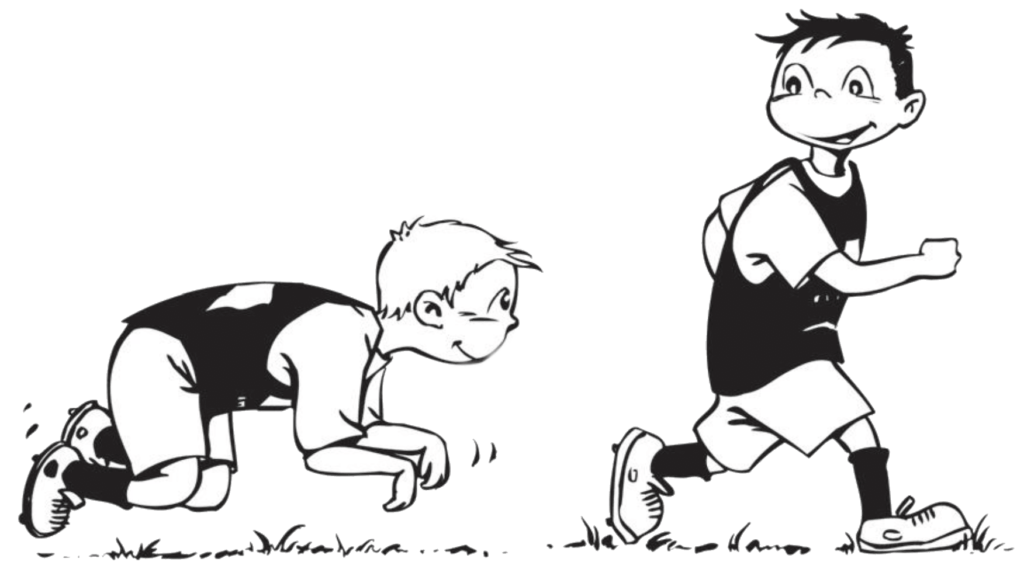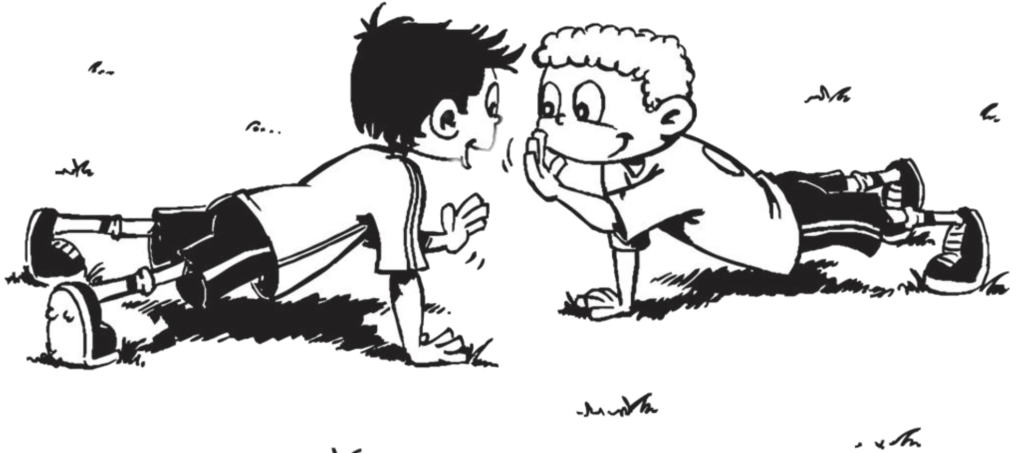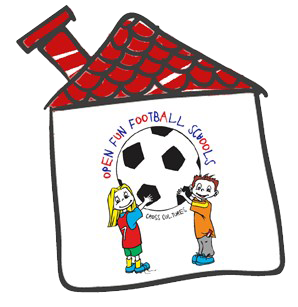Games
cooperation games

Communication and cooperation.
Chaotic movement in pairs in limited space
- The first player closes his/her eyes while the other is pushing him/her around and directing him/her where to go.
The first player leads and watches another player with his/her eyes closed.
Pairs with balls
The first player dribbles, feints, changes the direction, while the other is following and imitating his/her movements (at 2-3 metres distance).
Options:
- Both players have balls, they only change their roles.
- The first player is without the ball; he/she changes the rhythm, pace and direction; the other player has a ball with which he/she is following the first player around.
- Dribbling the ball after your partner; when he/she spreads his legs apart (signal) pass the ball through his/her legs and run past him/her.
- Dribbling the ball around your partner after a given signal (with the hand to the side).
A bout among the waves
In pairs, players stand facing each other. One player is holding both his/her ears with his/her hands. The other player holds the ball at chest-height and drops it without any signal. The player who’s holding his/her ears has to react quickly and catch the ball before it falls on the ground.

The bridge
This is another pair exercise in which one player tosses the ball under the bridge that his/her partner is imitating (through the legs, hands, etc.). Pairs are given pictures that show them how to cooperate. Players have to change roles all the time.
The invisible thread
Arms of one player (standing) and the legs of the other (sitting) are about 50 centimetres away from one another. The player that is standing is the guide he/she is moving his/her arms in all directions, while the other player is trying to imitate his/her actions with the legs and to keep the connection with his/her partners arms (move your arms up-down, left and right, cross-wise, etc.)
All the players in a group move randomly in a limited space carrying 4-5 balls in their hands. At a given signal (raise your arms, jump, sit down, etc.) pass the ball to the other team member asking for the ball.
Players dribble the ball in pairs, one behind the other. The second player is trying to imitate all the actions of the first player at 3-5 metres distance.

Collecting balls
Blindfolded and with the help of their partners (signals), players collect a ball and take it into a marked circle, go back and collect another ball from its initial place and repeat the activity. This game can be played with 2-4 teams whereby each team is given 4 balls. The first team to finish wins the game.
Hitting the hoop
Form two teams of eight. With their backs to the hoops, they throw the balls over their heads. The players are allowed to take a look at the hoop before they shoot. The team that scores the most points wins.
Pinocchio
This is another exercise for pairs. One of the players leads his/her partner on a chain in different directions, performing different tasks at the same time. The tasks can be either running (changing direction), jumping, lying down, getting through the legs, or some other objects, various rotations, etc.
Hand (foot) tennis (across arms)
Players work in pairs holding one anothers hands (as in a handshake). They are tossing the ball with the other hand (foot) across the handshake. Each player is allowed to have one contact with the ball. They must on no account release their handshake and they have to move together quickly to make the task easier to perform.

Exercises for pairs and threes
- Standing face to face, pushing, and pulling each other holding hands.
- Pushing each other with the chest, back and shoulders. Do not use your hands.
- Standing face to face and holding hands, try to maintain your balance. Tips of your feet are pointed at one another, shoulders pulled back with arms wide open.
- The same as above, except that the players are standing side-by side holding one another’s closer hand. They are trying to stretch their arms and maintain their balance.

- Supported on their hands and face to face one to another, players are trying to hit their partner’s upper arms, simultaneously trying to avoid being hit themselves.
- One of the players is walking supported on his/her hands, while the other player is holding his/her feet up (imitating a wheelbarrow).
- In pairs, one player falls into the other’s arms (either facing him/her or with his/her back to his/her partner). Having caught him/her, the partner lifts him/her up to his/her original position. At first, players fall with their eyes open to gain confidence in their partner. Later, they can do this exercises with their eyes closed.
- This can also be done in threes, whereby two players toss the third player among themselves. He/she has to tighten his/her muscles to make the exercise easier to perform.

